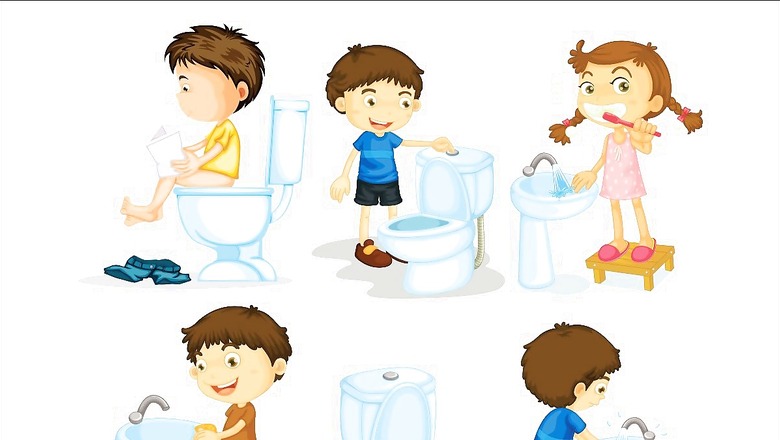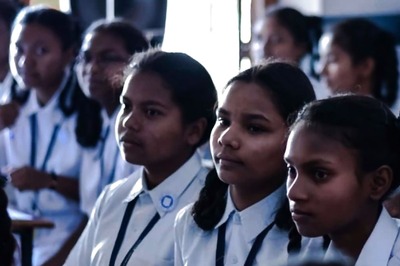
views
Parenting plays a pivotal role in shaping a child’s character and habits from a young age. One crucial aspect of child-rearing is toilet training. Teaching toddlers good toilet habits not only promotes cleanliness but also instils a sense of responsibility early on. By learning to recognize and respond to their bodily signals, toddlers gain a sense of autonomy and control over their own bodies. By following simple rules and routines, toddlers learn to respect their environment and the people around them.
Toilet training can also have benefits for your child’s health. When you transition away from diapers, you reduce the risk of rashes, urinary tract infections and other skin irritations. When children learn handwashing behaviours, it limits their exposure to germs and diseases. Moreover, once children transition to the potty, they usually tend to sleep better, without the dampness and discomfort of a diaper.
For new parents though, potty training can be daunting. The good news is that there is a lot of advice available online. The bad news is these sources often conflict with each other. In order to help bring some sanity in this space, we’ve pulled together some key recommendations that everyone seems to agree on.
Starting at the Right Time
Toilet training is a milestone that varies from child to child. Instead of rushing, observe your toddler’s readiness cues to identify the appropriate time to start. Generally, toddlers aged between 18 and 24 months show signs of readiness such as showing interest in the bathroom, pulling down their pants, or expressing discomfort with soiled diapers. Recognizing these cues and starting at the right time can set the foundation for successful toilet training.
Create a Comfortable Environment
Creating a comfortable and inviting environment is crucial to help toddlers feel at ease during the toilet training process. In Indian households, the bathroom may be perceived as a dark and scary place, especially during the night. Add some night lights to make the bathroom less intimidating and ensure your child’s safety. Ensure that the child can easily reach the toilet, sink, soap, towels and tissues and wipes (if you use them). Additionally, you can decorate the bathroom with colourful and child-friendly accessories to make it an enjoyable space.
Invest in Child-Friendly Potty Seats
Introducing a child-friendly potty seat can make a significant difference in your toddler’s toilet training journey. Traditional Indian toilets can be challenging for little ones to use independently. Therefore, consider purchasing a child-sized potty chair or a potty seat that can be placed on top of the regular toilet. This will make the process more comfortable and less daunting for the child.
Teach Proper Hygiene
Good toilet habits go hand in hand with proper hygiene practices. Teach your toddler the importance of washing hands with soap and water after using the toilet. In Indian culture, using water for cleaning after using the toilet is common, so instil this practice in a hygienic manner from an early age. Teach them how to flush correctly, and make it easy for them to close the toilet lid. Make sure to keep hand washing fun by using colourful soap or singing a short handwashing song together.
Make it a Fun Learning Experience
Incorporate fun elements into the toilet training routine to make it an enjoyable learning experience for your toddler. You can use engaging picture books, animated videos, or songs related to toilet habits. In an Indian context, there are traditional rhymes and stories that can be modified to teach good toilet habits in a playful manner. Making the process enjoyable will encourage the child to participate willingly.
Be Patient and Supportive
Toilet training can be a challenging time for both parents and toddlers. It is essential to be patient and supportive throughout the process. Understand that accidents are a normal part of the learning curve, and scolding or shaming the child can be counterproductive. Instead, offer reassurance and encouragement, and let your child know that it’s okay to make mistakes as they learn.
Be a Role Model
Toddlers often imitate their parents and caregivers, so ensure you are setting a good example. When your child sees you using the bathroom correctly and washing your hands afterward, they are more likely to follow suit. In an Indian context, where joint families are common, older siblings can also play a significant role in influencing the younger ones positively.
Good Toilet Hygiene Habits Last a Lifetime
Toilet training is a significant milestone in a toddler’s life, and nurturing good toilet habits can lay the groundwork for a responsible and hygienic future. As the Sub-Group of Chief Ministers on Swachh Bharat Abhiyaan found, children can be formidable agents of change.
Harpic, India’s leading brand in the lavatory care segment, recognises the impact children can have and has directed its most thought-provoking campaigns and outreach programs towards them. Harpic has also partnered with News18 in the Mission Swachhta aur Paani Initiative, which has, for 3 years now, championed the cause of inclusive sanitation where everyone has access to clean toilets. It advocates equality for all genders, abilities, castes and classes and strongly believes that clean toilets are a shared responsibility.
Under the aegis of Mission Swachhta aur Paani, Harpic partnered with Sesame Workshop India, an educational non-profit working for the early developmental needs of young children, to promote positive sanitation, hygiene knowledge and behaviours among children and families through schools and communities, engaging with 17.5 million children across India. This, in addition to the messaging they already aimed at adults.
In addition to outreach programs, Mission Swachhta aur Paani is also fueling change by empowering parents. It is a valuable repository of information on nearly every topic on toilets and sanitation – from articles to panel discussions to easy to consume video content. If there is a toilet and hygiene related topic you want to talk to your children about, you’ll find the resources you’ll need here.
With the Swachh Bharat Abhiyaan, India is firmly stepping away from a past where children succumbed to avoidable communicable diseases caused by poor sanitation and a lack of access to toilets. Each child that grows up using the toilet correctly and safely furthers our march towards a Swasth and Swachh Bharat, and builds a society we can all be proud of.




















Comments
0 comment